Child Adolescent Family Health: PHC Approach in Remote Areas
VerifiedAdded on 2023/04/25
|14
|3549
|403
Report
AI Summary
This report examines the role of Primary Health Care (PHC) in supporting nurses working with children and families in rural and remote Australia. It highlights the importance of addressing chronic conditions in adolescents, especially in underserved regions, and emphasizes the need for awareness of PHC services. The report discusses how PHC facilitates access to medical services, empowers families, and fosters relationships between healthcare professionals and families. It also explores health promotion programs, such as improving adolescent eating habits, and health education topics, like stress reduction, that can enhance the well-being of children and families. The findings suggest that PHC guidelines positively impact the relationship between nurses, adolescents, and their families, and that addressing gaps in healthcare provision requires a systematic approach involving community diversity and awareness of available PHC services. The report concludes with recommendations for strengthening PHC and improving equitable access to healthcare in rural and remote areas.

Running head: CHILD ADOLESCENT FAMILY HEALTH 1
Child Adolescent Family Health
Name
Institution
Child Adolescent Family Health
Name
Institution
Paraphrase This Document
Need a fresh take? Get an instant paraphrase of this document with our AI Paraphraser
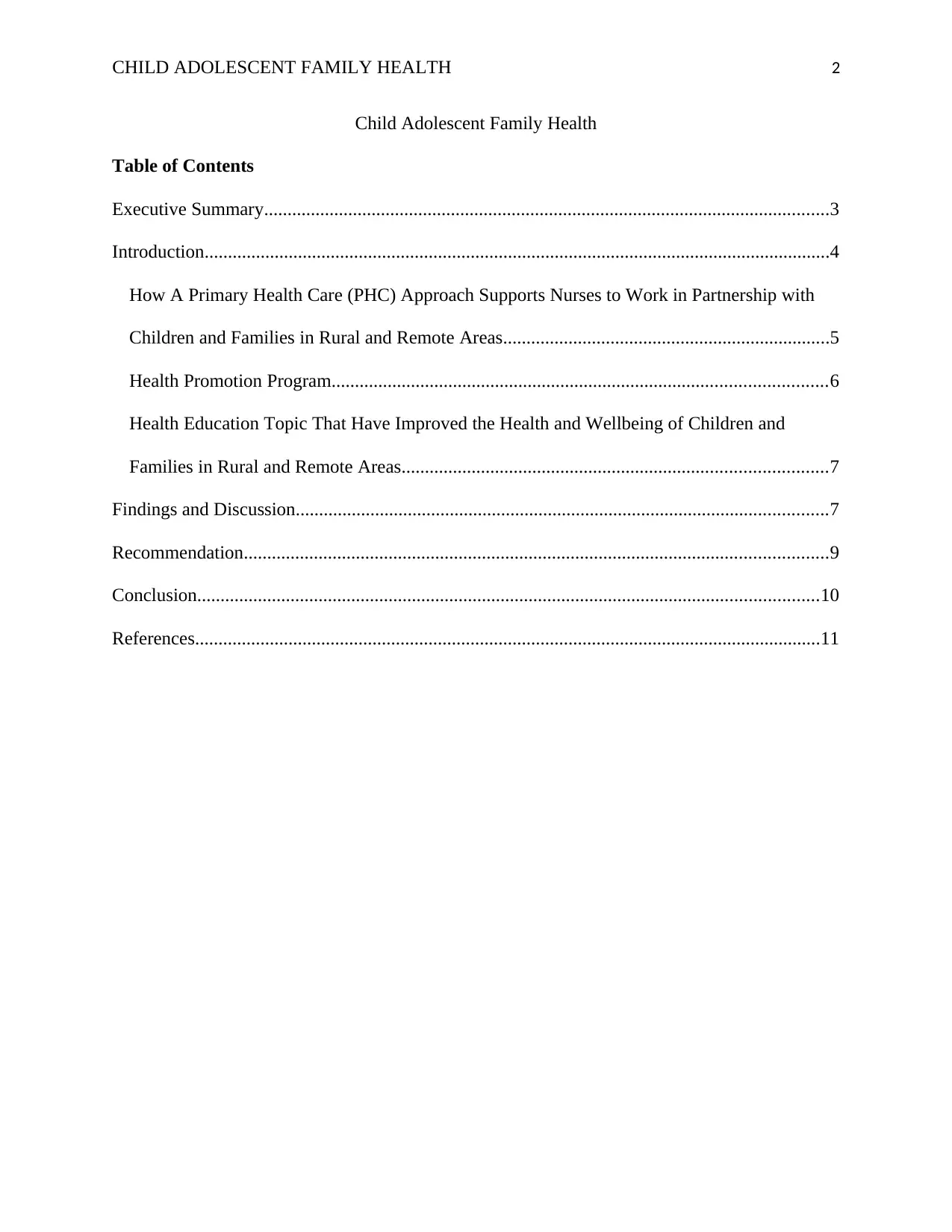
CHILD ADOLESCENT FAMILY HEALTH 2
Child Adolescent Family Health
Table of Contents
Executive Summary.........................................................................................................................3
Introduction......................................................................................................................................4
How A Primary Health Care (PHC) Approach Supports Nurses to Work in Partnership with
Children and Families in Rural and Remote Areas......................................................................5
Health Promotion Program..........................................................................................................6
Health Education Topic That Have Improved the Health and Wellbeing of Children and
Families in Rural and Remote Areas...........................................................................................7
Findings and Discussion..................................................................................................................7
Recommendation.............................................................................................................................9
Conclusion.....................................................................................................................................10
References......................................................................................................................................11
Child Adolescent Family Health
Table of Contents
Executive Summary.........................................................................................................................3
Introduction......................................................................................................................................4
How A Primary Health Care (PHC) Approach Supports Nurses to Work in Partnership with
Children and Families in Rural and Remote Areas......................................................................5
Health Promotion Program..........................................................................................................6
Health Education Topic That Have Improved the Health and Wellbeing of Children and
Families in Rural and Remote Areas...........................................................................................7
Findings and Discussion..................................................................................................................7
Recommendation.............................................................................................................................9
Conclusion.....................................................................................................................................10
References......................................................................................................................................11
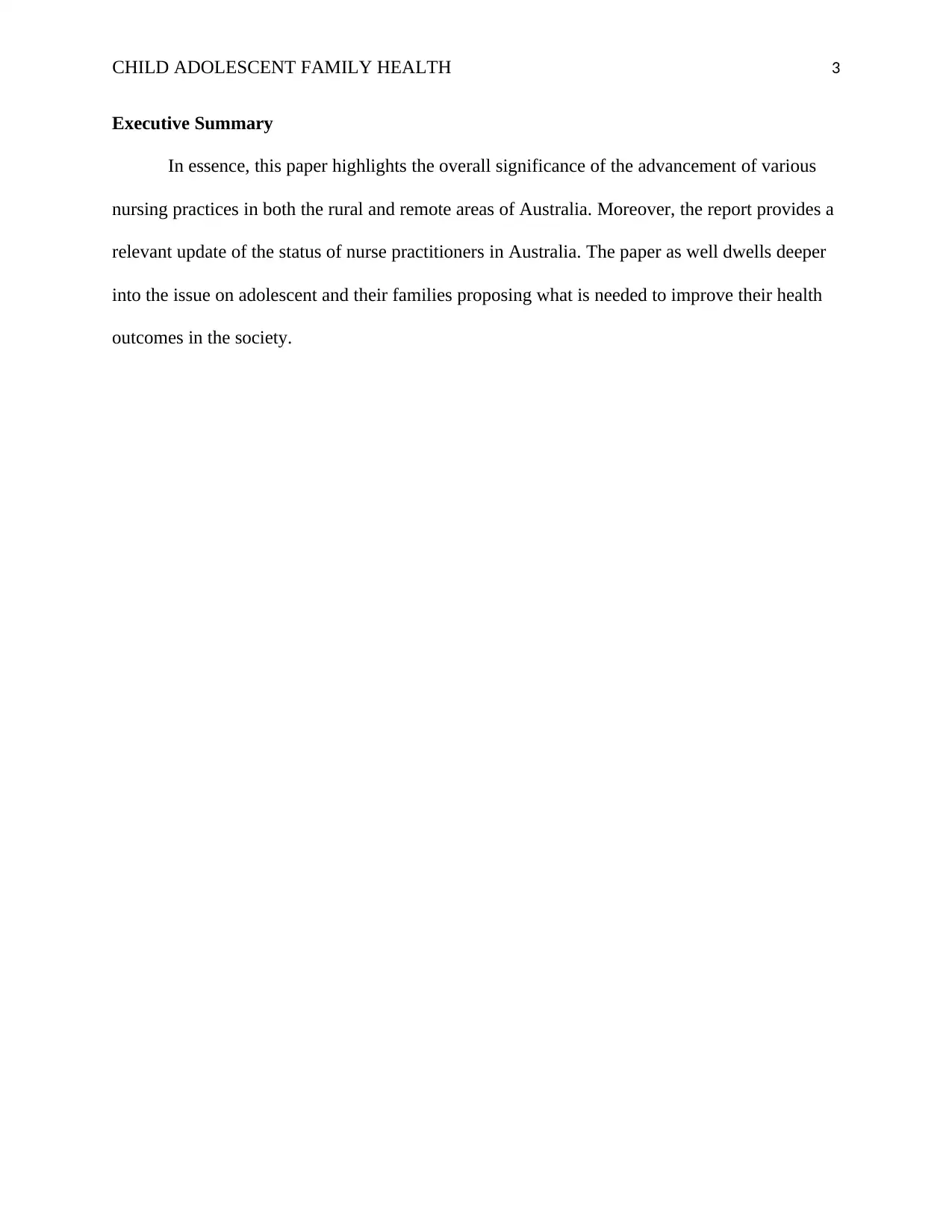
CHILD ADOLESCENT FAMILY HEALTH 3
Executive Summary
In essence, this paper highlights the overall significance of the advancement of various
nursing practices in both the rural and remote areas of Australia. Moreover, the report provides a
relevant update of the status of nurse practitioners in Australia. The paper as well dwells deeper
into the issue on adolescent and their families proposing what is needed to improve their health
outcomes in the society.
Executive Summary
In essence, this paper highlights the overall significance of the advancement of various
nursing practices in both the rural and remote areas of Australia. Moreover, the report provides a
relevant update of the status of nurse practitioners in Australia. The paper as well dwells deeper
into the issue on adolescent and their families proposing what is needed to improve their health
outcomes in the society.
⊘ This is a preview!⊘
Do you want full access?
Subscribe today to unlock all pages.

Trusted by 1+ million students worldwide

CHILD ADOLESCENT FAMILY HEALTH 4
Introduction
It is essential to point out that a chronic condition requires special attention particularly
from the government medical specialists. Notably, adolescent children especially in rural and
remote regions of Australia have undoubtedly faced neglect for a long time. In this light, there is
need for awareness of various medical services provided by the primary health care (PHC) (Zwar
et al., 2017). Primary Health Care is, therefore, regarded as an approach within the health care
system that often promotes the access of medical services by all people in the society including
rural and remote areas. PHC builds relationship between nurses, families, and the adolescent in
the rural and remote areas through the services and awareness campaigns medical specialists
performs in such areas (Zwar et al., 2017). In essence, Primary Health Care (PHC) approaches
are designed to permeate virtually all practices that involve child care as well as involving
families in all education procedures (Zwar et al., 2017). Notably, this is to make sure that
education departs from a reality point of experience through family setup and in a dialogical
relationship (Kyei-Nimakoh, Carolan-Olah, & McCann, 2017). In the care of a particular child or
the adolescent who has a chronic illness, health education is a significant process in achieving
autonomy, acceptance, as well as a routing way in managing health conditions, therefore, making
it easier to maintain and prevent various recurrent and future hospitalizations (Zwar et al., 2017).
With this said, Australia is regarded to be a country that enjoys good health, therefore,
experiencing one of the highest life expectancies across the world. Nonetheless, many Australian
residents, particularly from the rural as well as remote societies, tend to experience poor health
outcomes when compared to people who come from metropolitan areas in Australia. Notably,
the rate of hospitalization, as well as preventable disease, tends to increase with the overall
remoteness of a city. As a result, adolescent children have been on a higher risk of suffering from
Introduction
It is essential to point out that a chronic condition requires special attention particularly
from the government medical specialists. Notably, adolescent children especially in rural and
remote regions of Australia have undoubtedly faced neglect for a long time. In this light, there is
need for awareness of various medical services provided by the primary health care (PHC) (Zwar
et al., 2017). Primary Health Care is, therefore, regarded as an approach within the health care
system that often promotes the access of medical services by all people in the society including
rural and remote areas. PHC builds relationship between nurses, families, and the adolescent in
the rural and remote areas through the services and awareness campaigns medical specialists
performs in such areas (Zwar et al., 2017). In essence, Primary Health Care (PHC) approaches
are designed to permeate virtually all practices that involve child care as well as involving
families in all education procedures (Zwar et al., 2017). Notably, this is to make sure that
education departs from a reality point of experience through family setup and in a dialogical
relationship (Kyei-Nimakoh, Carolan-Olah, & McCann, 2017). In the care of a particular child or
the adolescent who has a chronic illness, health education is a significant process in achieving
autonomy, acceptance, as well as a routing way in managing health conditions, therefore, making
it easier to maintain and prevent various recurrent and future hospitalizations (Zwar et al., 2017).
With this said, Australia is regarded to be a country that enjoys good health, therefore,
experiencing one of the highest life expectancies across the world. Nonetheless, many Australian
residents, particularly from the rural as well as remote societies, tend to experience poor health
outcomes when compared to people who come from metropolitan areas in Australia. Notably,
the rate of hospitalization, as well as preventable disease, tends to increase with the overall
remoteness of a city. As a result, adolescent children have been on a higher risk of suffering from
Paraphrase This Document
Need a fresh take? Get an instant paraphrase of this document with our AI Paraphraser
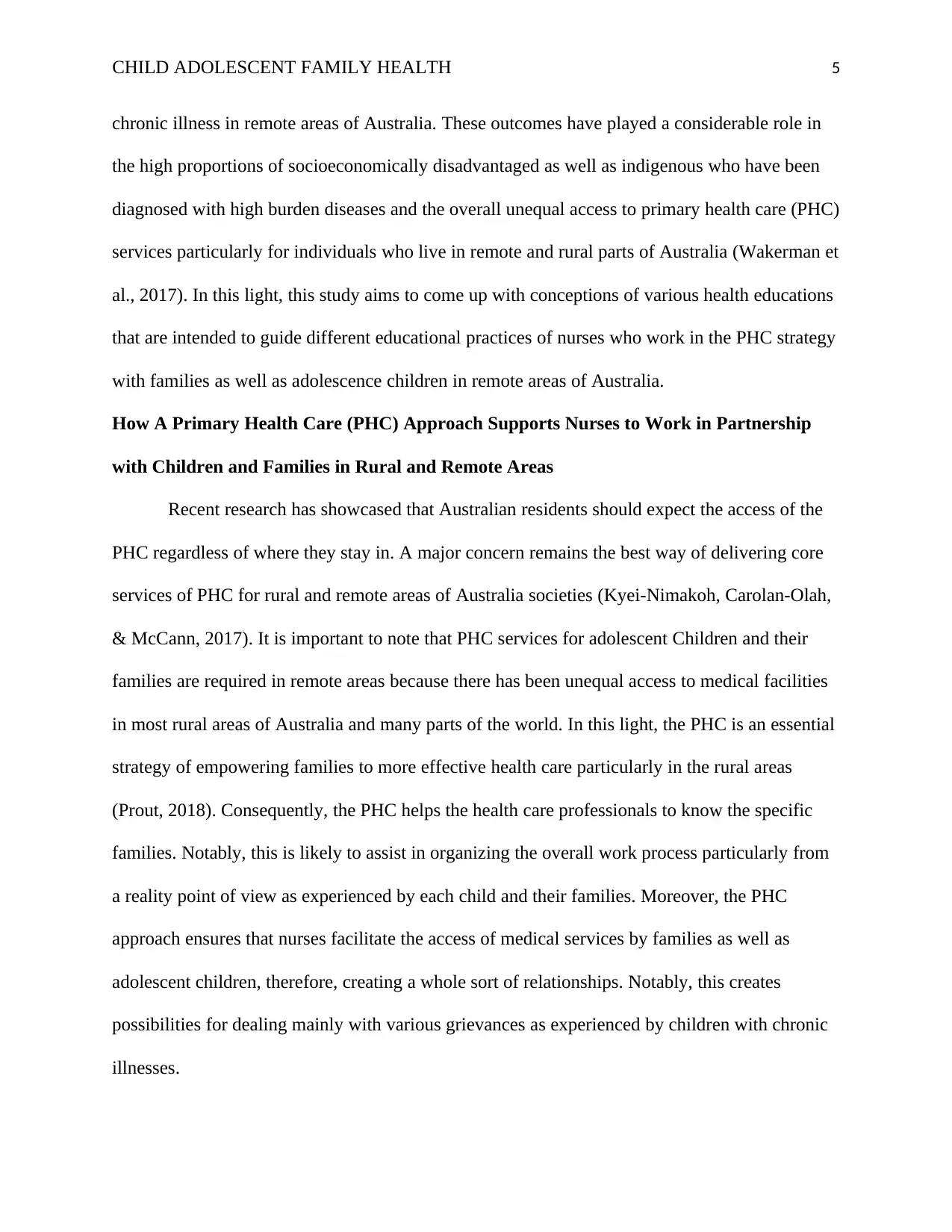
CHILD ADOLESCENT FAMILY HEALTH 5
chronic illness in remote areas of Australia. These outcomes have played a considerable role in
the high proportions of socioeconomically disadvantaged as well as indigenous who have been
diagnosed with high burden diseases and the overall unequal access to primary health care (PHC)
services particularly for individuals who live in remote and rural parts of Australia (Wakerman et
al., 2017). In this light, this study aims to come up with conceptions of various health educations
that are intended to guide different educational practices of nurses who work in the PHC strategy
with families as well as adolescence children in remote areas of Australia.
How A Primary Health Care (PHC) Approach Supports Nurses to Work in Partnership
with Children and Families in Rural and Remote Areas
Recent research has showcased that Australian residents should expect the access of the
PHC regardless of where they stay in. A major concern remains the best way of delivering core
services of PHC for rural and remote areas of Australia societies (Kyei-Nimakoh, Carolan-Olah,
& McCann, 2017). It is important to note that PHC services for adolescent Children and their
families are required in remote areas because there has been unequal access to medical facilities
in most rural areas of Australia and many parts of the world. In this light, the PHC is an essential
strategy of empowering families to more effective health care particularly in the rural areas
(Prout, 2018). Consequently, the PHC helps the health care professionals to know the specific
families. Notably, this is likely to assist in organizing the overall work process particularly from
a reality point of view as experienced by each child and their families. Moreover, the PHC
approach ensures that nurses facilitate the access of medical services by families as well as
adolescent children, therefore, creating a whole sort of relationships. Notably, this creates
possibilities for dealing mainly with various grievances as experienced by children with chronic
illnesses.
chronic illness in remote areas of Australia. These outcomes have played a considerable role in
the high proportions of socioeconomically disadvantaged as well as indigenous who have been
diagnosed with high burden diseases and the overall unequal access to primary health care (PHC)
services particularly for individuals who live in remote and rural parts of Australia (Wakerman et
al., 2017). In this light, this study aims to come up with conceptions of various health educations
that are intended to guide different educational practices of nurses who work in the PHC strategy
with families as well as adolescence children in remote areas of Australia.
How A Primary Health Care (PHC) Approach Supports Nurses to Work in Partnership
with Children and Families in Rural and Remote Areas
Recent research has showcased that Australian residents should expect the access of the
PHC regardless of where they stay in. A major concern remains the best way of delivering core
services of PHC for rural and remote areas of Australia societies (Kyei-Nimakoh, Carolan-Olah,
& McCann, 2017). It is important to note that PHC services for adolescent Children and their
families are required in remote areas because there has been unequal access to medical facilities
in most rural areas of Australia and many parts of the world. In this light, the PHC is an essential
strategy of empowering families to more effective health care particularly in the rural areas
(Prout, 2018). Consequently, the PHC helps the health care professionals to know the specific
families. Notably, this is likely to assist in organizing the overall work process particularly from
a reality point of view as experienced by each child and their families. Moreover, the PHC
approach ensures that nurses facilitate the access of medical services by families as well as
adolescent children, therefore, creating a whole sort of relationships. Notably, this creates
possibilities for dealing mainly with various grievances as experienced by children with chronic
illnesses.
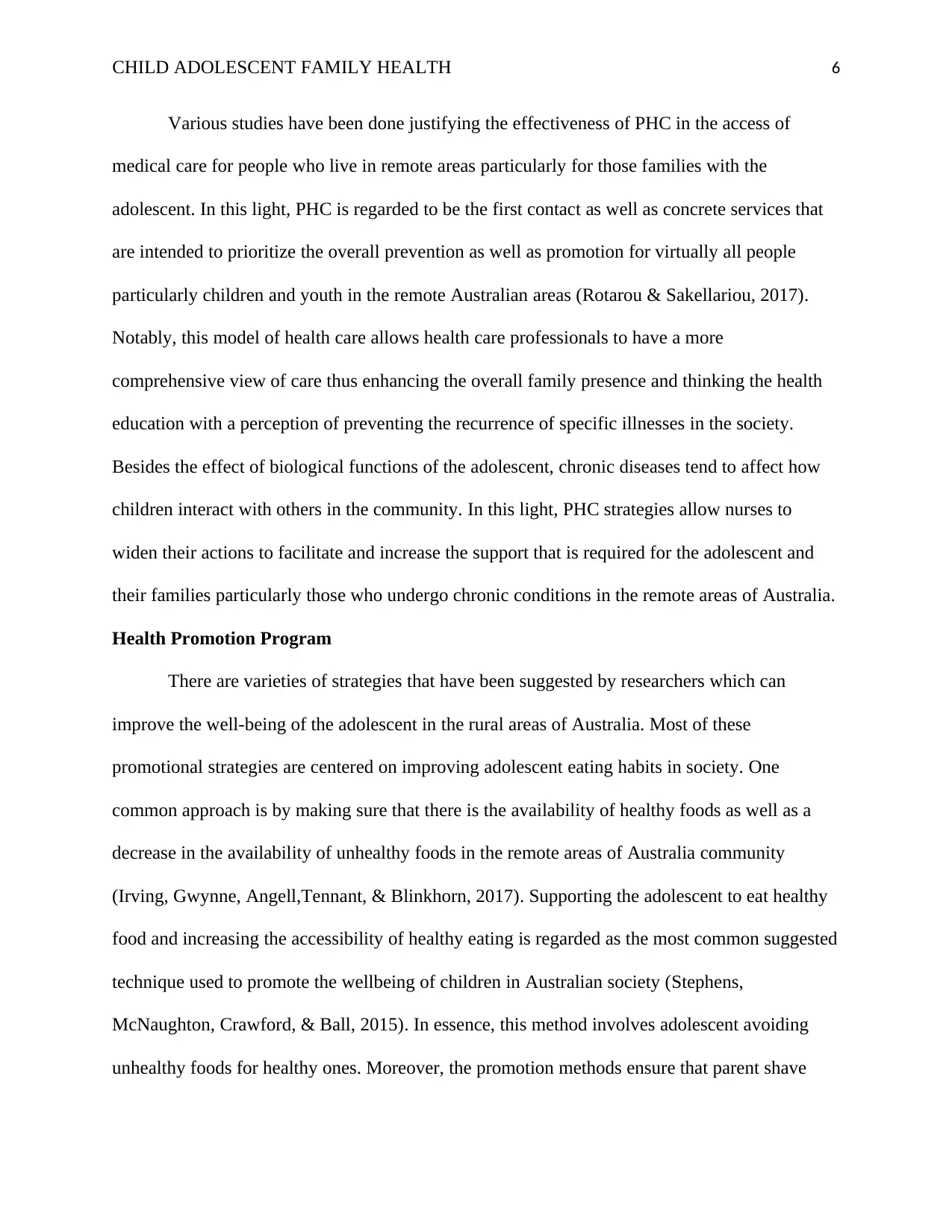
CHILD ADOLESCENT FAMILY HEALTH 6
Various studies have been done justifying the effectiveness of PHC in the access of
medical care for people who live in remote areas particularly for those families with the
adolescent. In this light, PHC is regarded to be the first contact as well as concrete services that
are intended to prioritize the overall prevention as well as promotion for virtually all people
particularly children and youth in the remote Australian areas (Rotarou & Sakellariou, 2017).
Notably, this model of health care allows health care professionals to have a more
comprehensive view of care thus enhancing the overall family presence and thinking the health
education with a perception of preventing the recurrence of specific illnesses in the society.
Besides the effect of biological functions of the adolescent, chronic diseases tend to affect how
children interact with others in the community. In this light, PHC strategies allow nurses to
widen their actions to facilitate and increase the support that is required for the adolescent and
their families particularly those who undergo chronic conditions in the remote areas of Australia.
Health Promotion Program
There are varieties of strategies that have been suggested by researchers which can
improve the well-being of the adolescent in the rural areas of Australia. Most of these
promotional strategies are centered on improving adolescent eating habits in society. One
common approach is by making sure that there is the availability of healthy foods as well as a
decrease in the availability of unhealthy foods in the remote areas of Australia community
(Irving, Gwynne, Angell,Tennant, & Blinkhorn, 2017). Supporting the adolescent to eat healthy
food and increasing the accessibility of healthy eating is regarded as the most common suggested
technique used to promote the wellbeing of children in Australian society (Stephens,
McNaughton, Crawford, & Ball, 2015). In essence, this method involves adolescent avoiding
unhealthy foods for healthy ones. Moreover, the promotion methods ensure that parent shave
Various studies have been done justifying the effectiveness of PHC in the access of
medical care for people who live in remote areas particularly for those families with the
adolescent. In this light, PHC is regarded to be the first contact as well as concrete services that
are intended to prioritize the overall prevention as well as promotion for virtually all people
particularly children and youth in the remote Australian areas (Rotarou & Sakellariou, 2017).
Notably, this model of health care allows health care professionals to have a more
comprehensive view of care thus enhancing the overall family presence and thinking the health
education with a perception of preventing the recurrence of specific illnesses in the society.
Besides the effect of biological functions of the adolescent, chronic diseases tend to affect how
children interact with others in the community. In this light, PHC strategies allow nurses to
widen their actions to facilitate and increase the support that is required for the adolescent and
their families particularly those who undergo chronic conditions in the remote areas of Australia.
Health Promotion Program
There are varieties of strategies that have been suggested by researchers which can
improve the well-being of the adolescent in the rural areas of Australia. Most of these
promotional strategies are centered on improving adolescent eating habits in society. One
common approach is by making sure that there is the availability of healthy foods as well as a
decrease in the availability of unhealthy foods in the remote areas of Australia community
(Irving, Gwynne, Angell,Tennant, & Blinkhorn, 2017). Supporting the adolescent to eat healthy
food and increasing the accessibility of healthy eating is regarded as the most common suggested
technique used to promote the wellbeing of children in Australian society (Stephens,
McNaughton, Crawford, & Ball, 2015). In essence, this method involves adolescent avoiding
unhealthy foods for healthy ones. Moreover, the promotion methods ensure that parent shave
⊘ This is a preview!⊘
Do you want full access?
Subscribe today to unlock all pages.

Trusted by 1+ million students worldwide
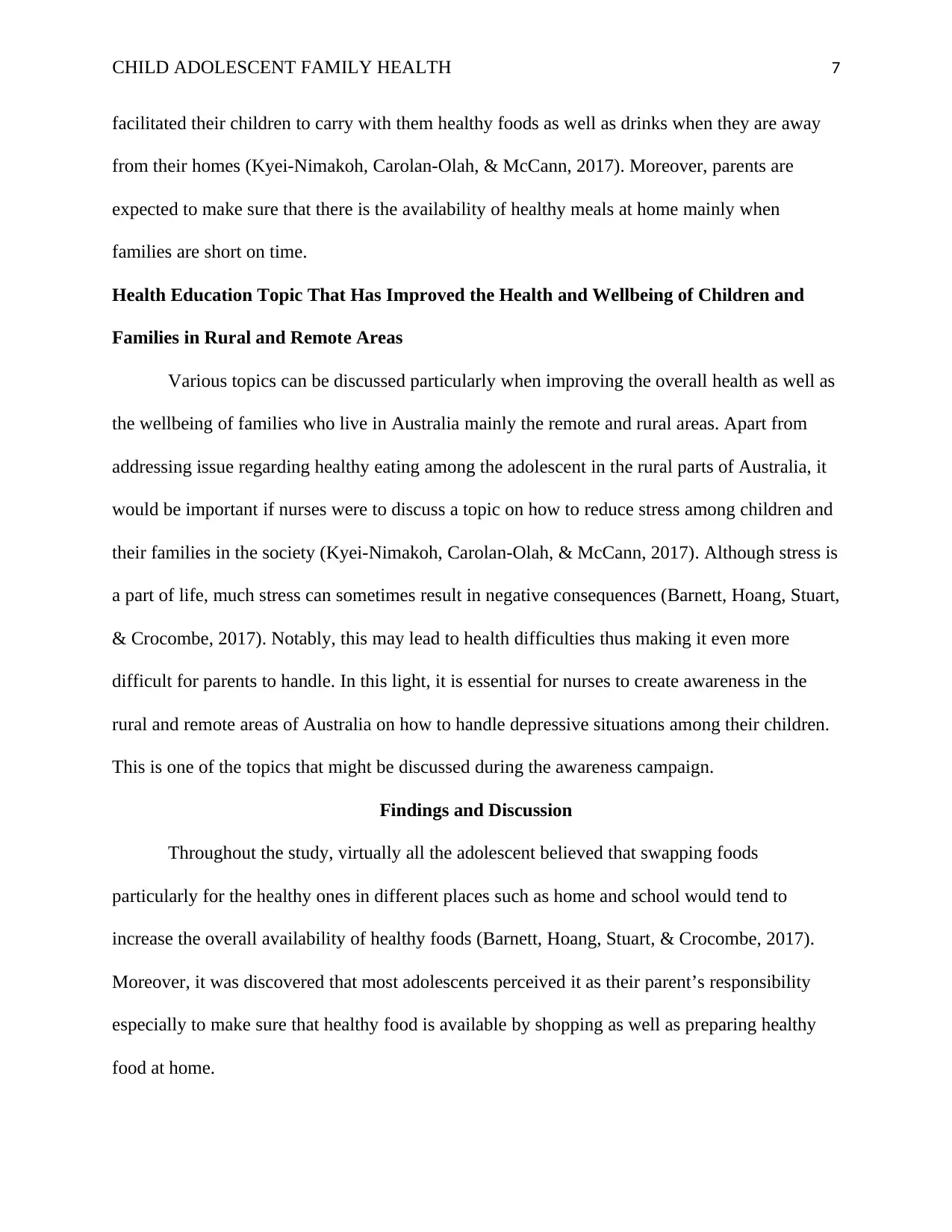
CHILD ADOLESCENT FAMILY HEALTH 7
facilitated their children to carry with them healthy foods as well as drinks when they are away
from their homes (Kyei-Nimakoh, Carolan-Olah, & McCann, 2017). Moreover, parents are
expected to make sure that there is the availability of healthy meals at home mainly when
families are short on time.
Health Education Topic That Has Improved the Health and Wellbeing of Children and
Families in Rural and Remote Areas
Various topics can be discussed particularly when improving the overall health as well as
the wellbeing of families who live in Australia mainly the remote and rural areas. Apart from
addressing issue regarding healthy eating among the adolescent in the rural parts of Australia, it
would be important if nurses were to discuss a topic on how to reduce stress among children and
their families in the society (Kyei-Nimakoh, Carolan-Olah, & McCann, 2017). Although stress is
a part of life, much stress can sometimes result in negative consequences (Barnett, Hoang, Stuart,
& Crocombe, 2017). Notably, this may lead to health difficulties thus making it even more
difficult for parents to handle. In this light, it is essential for nurses to create awareness in the
rural and remote areas of Australia on how to handle depressive situations among their children.
This is one of the topics that might be discussed during the awareness campaign.
Findings and Discussion
Throughout the study, virtually all the adolescent believed that swapping foods
particularly for the healthy ones in different places such as home and school would tend to
increase the overall availability of healthy foods (Barnett, Hoang, Stuart, & Crocombe, 2017).
Moreover, it was discovered that most adolescents perceived it as their parent’s responsibility
especially to make sure that healthy food is available by shopping as well as preparing healthy
food at home.
facilitated their children to carry with them healthy foods as well as drinks when they are away
from their homes (Kyei-Nimakoh, Carolan-Olah, & McCann, 2017). Moreover, parents are
expected to make sure that there is the availability of healthy meals at home mainly when
families are short on time.
Health Education Topic That Has Improved the Health and Wellbeing of Children and
Families in Rural and Remote Areas
Various topics can be discussed particularly when improving the overall health as well as
the wellbeing of families who live in Australia mainly the remote and rural areas. Apart from
addressing issue regarding healthy eating among the adolescent in the rural parts of Australia, it
would be important if nurses were to discuss a topic on how to reduce stress among children and
their families in the society (Kyei-Nimakoh, Carolan-Olah, & McCann, 2017). Although stress is
a part of life, much stress can sometimes result in negative consequences (Barnett, Hoang, Stuart,
& Crocombe, 2017). Notably, this may lead to health difficulties thus making it even more
difficult for parents to handle. In this light, it is essential for nurses to create awareness in the
rural and remote areas of Australia on how to handle depressive situations among their children.
This is one of the topics that might be discussed during the awareness campaign.
Findings and Discussion
Throughout the study, virtually all the adolescent believed that swapping foods
particularly for the healthy ones in different places such as home and school would tend to
increase the overall availability of healthy foods (Barnett, Hoang, Stuart, & Crocombe, 2017).
Moreover, it was discovered that most adolescents perceived it as their parent’s responsibility
especially to make sure that healthy food is available by shopping as well as preparing healthy
food at home.
Paraphrase This Document
Need a fresh take? Get an instant paraphrase of this document with our AI Paraphraser
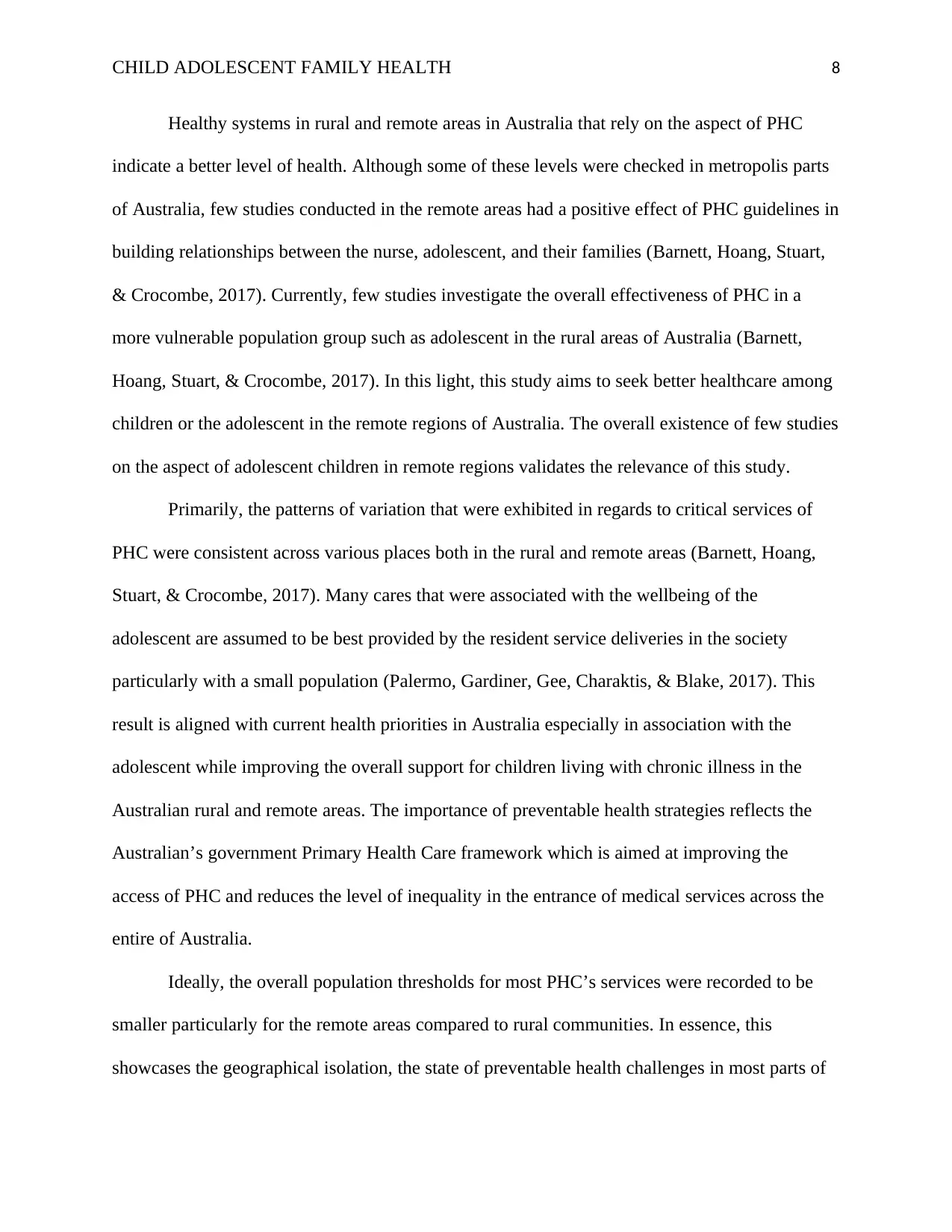
CHILD ADOLESCENT FAMILY HEALTH 8
Healthy systems in rural and remote areas in Australia that rely on the aspect of PHC
indicate a better level of health. Although some of these levels were checked in metropolis parts
of Australia, few studies conducted in the remote areas had a positive effect of PHC guidelines in
building relationships between the nurse, adolescent, and their families (Barnett, Hoang, Stuart,
& Crocombe, 2017). Currently, few studies investigate the overall effectiveness of PHC in a
more vulnerable population group such as adolescent in the rural areas of Australia (Barnett,
Hoang, Stuart, & Crocombe, 2017). In this light, this study aims to seek better healthcare among
children or the adolescent in the remote regions of Australia. The overall existence of few studies
on the aspect of adolescent children in remote regions validates the relevance of this study.
Primarily, the patterns of variation that were exhibited in regards to critical services of
PHC were consistent across various places both in the rural and remote areas (Barnett, Hoang,
Stuart, & Crocombe, 2017). Many cares that were associated with the wellbeing of the
adolescent are assumed to be best provided by the resident service deliveries in the society
particularly with a small population (Palermo, Gardiner, Gee, Charaktis, & Blake, 2017). This
result is aligned with current health priorities in Australia especially in association with the
adolescent while improving the overall support for children living with chronic illness in the
Australian rural and remote areas. The importance of preventable health strategies reflects the
Australian’s government Primary Health Care framework which is aimed at improving the
access of PHC and reduces the level of inequality in the entrance of medical services across the
entire of Australia.
Ideally, the overall population thresholds for most PHC’s services were recorded to be
smaller particularly for the remote areas compared to rural communities. In essence, this
showcases the geographical isolation, the state of preventable health challenges in most parts of
Healthy systems in rural and remote areas in Australia that rely on the aspect of PHC
indicate a better level of health. Although some of these levels were checked in metropolis parts
of Australia, few studies conducted in the remote areas had a positive effect of PHC guidelines in
building relationships between the nurse, adolescent, and their families (Barnett, Hoang, Stuart,
& Crocombe, 2017). Currently, few studies investigate the overall effectiveness of PHC in a
more vulnerable population group such as adolescent in the rural areas of Australia (Barnett,
Hoang, Stuart, & Crocombe, 2017). In this light, this study aims to seek better healthcare among
children or the adolescent in the remote regions of Australia. The overall existence of few studies
on the aspect of adolescent children in remote regions validates the relevance of this study.
Primarily, the patterns of variation that were exhibited in regards to critical services of
PHC were consistent across various places both in the rural and remote areas (Barnett, Hoang,
Stuart, & Crocombe, 2017). Many cares that were associated with the wellbeing of the
adolescent are assumed to be best provided by the resident service deliveries in the society
particularly with a small population (Palermo, Gardiner, Gee, Charaktis, & Blake, 2017). This
result is aligned with current health priorities in Australia especially in association with the
adolescent while improving the overall support for children living with chronic illness in the
Australian rural and remote areas. The importance of preventable health strategies reflects the
Australian’s government Primary Health Care framework which is aimed at improving the
access of PHC and reduces the level of inequality in the entrance of medical services across the
entire of Australia.
Ideally, the overall population thresholds for most PHC’s services were recorded to be
smaller particularly for the remote areas compared to rural communities. In essence, this
showcases the geographical isolation, the state of preventable health challenges in most parts of

CHILD ADOLESCENT FAMILY HEALTH 9
the indigenous communities as well as the problems in the provision of an effective and
sustainable PHC equitably in rural and remote areas compared to the metropolitan areas of
Australia (Dawson et al., 2017). It is, therefore, important to point out that improving the
equitable access for health care services in rural and remote regions of Australia requires more
than making sure that the health practitioners are on the ground. Ensuring that there is efficient
utilization of PHC services among parents and children or the adolescent is proportionate to the
societal needs.
Furthermore, even though there is a significant role particularly for consumers in coming
up with a workable community planning or strategy, there are those members of the community
in the rural as well as remote areas who might not be aware of the variety of PHC services
available to the modern society (Woodgate et al., 2017). In this light, it is the responsibility of
health planning for the community to take into account the community diversity and ensure that
even those in the remote areas are aware of all the PHC services. These findings prove essential
in establishing a systematic strategy, particularly to the health workforce with the aim of
addressing the gaps in the provision of health care services in the remote and rural areas of
Australia (Freeman, Abdullah, Ford, & Taing, 2017). Additionally, this study provides the
policymakers with a somewhat systematic approach to strengthen PHC with the community
which is a high need for better health care services.
Recommendation
In essence, the Australian nursing governing council should fund a various projects with
the aim of validating the National Nursing Organization’s standards for the purpose, particularly
of the registered nurses in the remote and rural parts of Australia (Barnett, Hoang, Stuart, &
Crocombe, 2017).
the indigenous communities as well as the problems in the provision of an effective and
sustainable PHC equitably in rural and remote areas compared to the metropolitan areas of
Australia (Dawson et al., 2017). It is, therefore, important to point out that improving the
equitable access for health care services in rural and remote regions of Australia requires more
than making sure that the health practitioners are on the ground. Ensuring that there is efficient
utilization of PHC services among parents and children or the adolescent is proportionate to the
societal needs.
Furthermore, even though there is a significant role particularly for consumers in coming
up with a workable community planning or strategy, there are those members of the community
in the rural as well as remote areas who might not be aware of the variety of PHC services
available to the modern society (Woodgate et al., 2017). In this light, it is the responsibility of
health planning for the community to take into account the community diversity and ensure that
even those in the remote areas are aware of all the PHC services. These findings prove essential
in establishing a systematic strategy, particularly to the health workforce with the aim of
addressing the gaps in the provision of health care services in the remote and rural areas of
Australia (Freeman, Abdullah, Ford, & Taing, 2017). Additionally, this study provides the
policymakers with a somewhat systematic approach to strengthen PHC with the community
which is a high need for better health care services.
Recommendation
In essence, the Australian nursing governing council should fund a various projects with
the aim of validating the National Nursing Organization’s standards for the purpose, particularly
of the registered nurses in the remote and rural parts of Australia (Barnett, Hoang, Stuart, &
Crocombe, 2017).
⊘ This is a preview!⊘
Do you want full access?
Subscribe today to unlock all pages.

Trusted by 1+ million students worldwide

CHILD ADOLESCENT FAMILY HEALTH 10
Ideally, it is proposed that both the private as well as the public sectors including the
Australian health specialists work together with the aim of providing better health care services
to the remote and rural communities (Gurung, Derrett, Gauld, & Hill, 2017).
Furthermore, the Australian Department of health should establish a dedicated nursing
unit that is headed by a director of nursing to make sure that there are established policies that
are intended to uplift the health care services in the rural and remote areas of Australia (Barnett,
Hoang, Stuart, & Crocombe, 2017).
The public health sectors in Australia should make sure that it provides all the nurses
especially in advance practices in rural as well as remote areas with a better remuneration that is
equivalent to their skills and training (Roufeil & Battye, 2014). Additionally, there is a need for
improving the working conditions in rural and remote areas to facilitate the provision of health
care services in Australia. Moreover, there should be an increase in nursing promotional program
aimed at increasing the number of nurses in the health care facilities across the remote and rural
Australia.
The Australian government should as well ensure that there are awareness campaigns
particularly to the families and children or the adolescent in the rural and remote areas. Notably,
this will ensure that people from remote areas are aware of the critical services of PHC in
improving their wellbeing (Barnett, Hoang, Stuart, & Crocombe, 2017).
Conclusion
In essence, nurse-parental care is an essential approach in establishing as well as
monitoring the entire process of development of a child or the adolescent, particularly in rural
and remote communities. Particularly to the adolescent in the society, families, as well as
children, are at high risks especially those that come from a lower income society. In this light,
Ideally, it is proposed that both the private as well as the public sectors including the
Australian health specialists work together with the aim of providing better health care services
to the remote and rural communities (Gurung, Derrett, Gauld, & Hill, 2017).
Furthermore, the Australian Department of health should establish a dedicated nursing
unit that is headed by a director of nursing to make sure that there are established policies that
are intended to uplift the health care services in the rural and remote areas of Australia (Barnett,
Hoang, Stuart, & Crocombe, 2017).
The public health sectors in Australia should make sure that it provides all the nurses
especially in advance practices in rural as well as remote areas with a better remuneration that is
equivalent to their skills and training (Roufeil & Battye, 2014). Additionally, there is a need for
improving the working conditions in rural and remote areas to facilitate the provision of health
care services in Australia. Moreover, there should be an increase in nursing promotional program
aimed at increasing the number of nurses in the health care facilities across the remote and rural
Australia.
The Australian government should as well ensure that there are awareness campaigns
particularly to the families and children or the adolescent in the rural and remote areas. Notably,
this will ensure that people from remote areas are aware of the critical services of PHC in
improving their wellbeing (Barnett, Hoang, Stuart, & Crocombe, 2017).
Conclusion
In essence, nurse-parental care is an essential approach in establishing as well as
monitoring the entire process of development of a child or the adolescent, particularly in rural
and remote communities. Particularly to the adolescent in the society, families, as well as
children, are at high risks especially those that come from a lower income society. In this light,
Paraphrase This Document
Need a fresh take? Get an instant paraphrase of this document with our AI Paraphraser

CHILD ADOLESCENT FAMILY HEALTH 11
the presence and attributes of the PHC have proven to be of great importance especially in
achieving a level of adherence as well as care in a continuous manner for the adolescent. When
handling a matter that are related to health education, it is important to note that the main aim or
goal for such a mission is to make sure that there is improved health care services.
It is clear that the majority of the rural and remote residents continuously experience
poorer but avoidable health consequences compared to people on the metropolitan parts of
Australia. In this light, more equitable accessibility of the PHC services mainly in the rural as
well as remote Australian community is essential. Notably, this is likely to contribute to the
overall reduction in the rate of preventable illnesses among the adolescent in society.
the presence and attributes of the PHC have proven to be of great importance especially in
achieving a level of adherence as well as care in a continuous manner for the adolescent. When
handling a matter that are related to health education, it is important to note that the main aim or
goal for such a mission is to make sure that there is improved health care services.
It is clear that the majority of the rural and remote residents continuously experience
poorer but avoidable health consequences compared to people on the metropolitan parts of
Australia. In this light, more equitable accessibility of the PHC services mainly in the rural as
well as remote Australian community is essential. Notably, this is likely to contribute to the
overall reduction in the rate of preventable illnesses among the adolescent in society.

CHILD ADOLESCENT FAMILY HEALTH 12
References
Barnett, T., Hoang, H., Stuart, J., & Crocombe, L. (2017). The relationship of primary care
providers to dental practitioners in rural and remote Australia. BMC health services
research, 17(1), 515.
Dawson, S., Gerace, A., Muir-Cochrane, E., O'Kane, D., Henderson, J., Lawn, S., & Fuller, J.
(2017). Carers' experiences of accessing and navigating mental health care for older
people in a rural area in Australia. Aging & mental health, 21(2), 216-223.
Freeman, C. R., Abdullah, N., Ford, P. J., & Taing, M. W. (2017). A national survey exploring
oral healthcare service provision across Australian community pharmacies. BMJ
open, 7(9), e017940.
Gurung, G., Derrett, S., Gauld, R., & Hill, P. C. (2017). Why service users do not complain or
have ‘voice’: a mixed-methods study from Nepal’s rural primary health care
system. BMC health services research, 17(1), 81.
Irving, M., Gwynne, K., Angell, B., Tennant, M., & Blinkhorn, A. (2017). Client perspectives on
an Aboriginal community led oral health service in rural Australia. Australian Journal of
Rural Health, 25(3), 163-168.
Kyei-Nimakoh, M., Carolan-Olah, M., & McCann, T. V. (2017). Access barriers to obstetric care
at health facilities in sub-Saharan Africa—a systematic review. Systematic reviews, 6(1),
110.
Palermo, C., Gardiner, B., Gee, C., Charaktis, S., & Blake, M. (2017). A mixed-methods impact
evaluation of the feasibility of an initiative in small rural stores to improve access to fruit
and vegetables. Australian journal of primary health, 22(6), 545-553.
References
Barnett, T., Hoang, H., Stuart, J., & Crocombe, L. (2017). The relationship of primary care
providers to dental practitioners in rural and remote Australia. BMC health services
research, 17(1), 515.
Dawson, S., Gerace, A., Muir-Cochrane, E., O'Kane, D., Henderson, J., Lawn, S., & Fuller, J.
(2017). Carers' experiences of accessing and navigating mental health care for older
people in a rural area in Australia. Aging & mental health, 21(2), 216-223.
Freeman, C. R., Abdullah, N., Ford, P. J., & Taing, M. W. (2017). A national survey exploring
oral healthcare service provision across Australian community pharmacies. BMJ
open, 7(9), e017940.
Gurung, G., Derrett, S., Gauld, R., & Hill, P. C. (2017). Why service users do not complain or
have ‘voice’: a mixed-methods study from Nepal’s rural primary health care
system. BMC health services research, 17(1), 81.
Irving, M., Gwynne, K., Angell, B., Tennant, M., & Blinkhorn, A. (2017). Client perspectives on
an Aboriginal community led oral health service in rural Australia. Australian Journal of
Rural Health, 25(3), 163-168.
Kyei-Nimakoh, M., Carolan-Olah, M., & McCann, T. V. (2017). Access barriers to obstetric care
at health facilities in sub-Saharan Africa—a systematic review. Systematic reviews, 6(1),
110.
Palermo, C., Gardiner, B., Gee, C., Charaktis, S., & Blake, M. (2017). A mixed-methods impact
evaluation of the feasibility of an initiative in small rural stores to improve access to fruit
and vegetables. Australian journal of primary health, 22(6), 545-553.
⊘ This is a preview!⊘
Do you want full access?
Subscribe today to unlock all pages.

Trusted by 1+ million students worldwide
1 out of 14
Related Documents
Your All-in-One AI-Powered Toolkit for Academic Success.
+13062052269
info@desklib.com
Available 24*7 on WhatsApp / Email
![[object Object]](/_next/static/media/star-bottom.7253800d.svg)
Unlock your academic potential
Copyright © 2020–2025 A2Z Services. All Rights Reserved. Developed and managed by ZUCOL.





